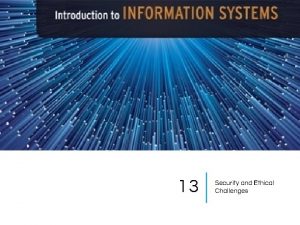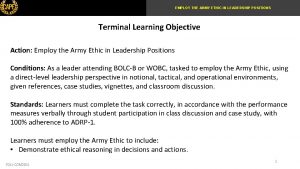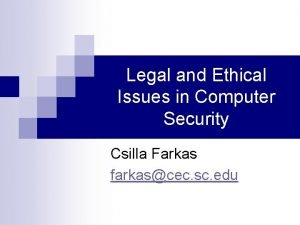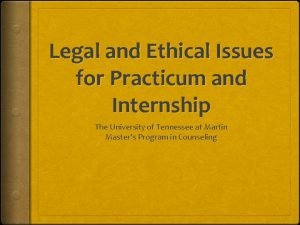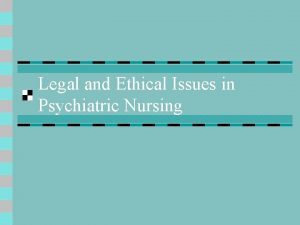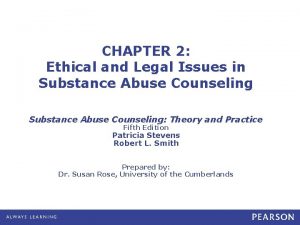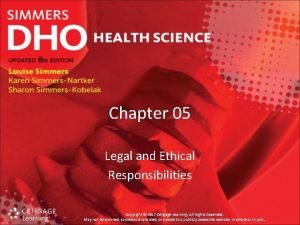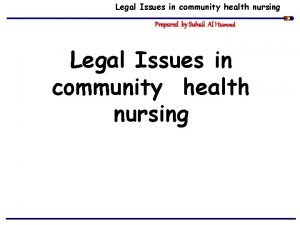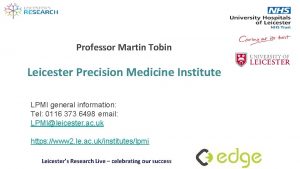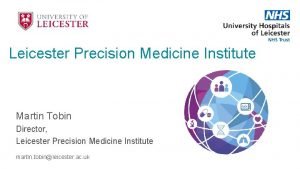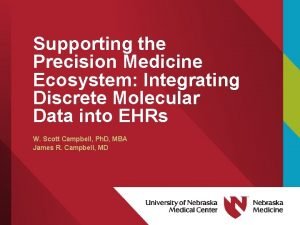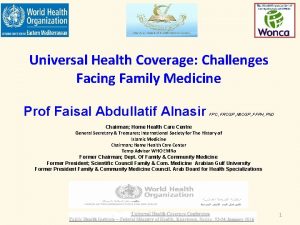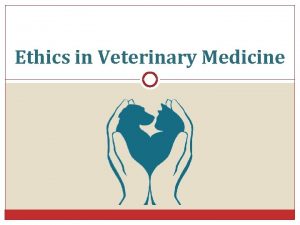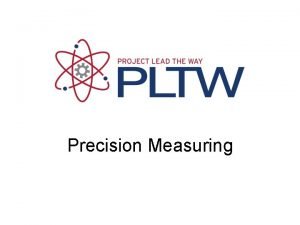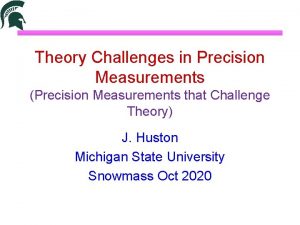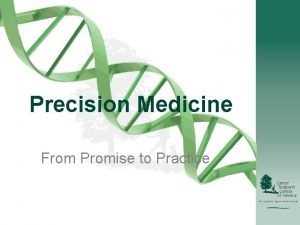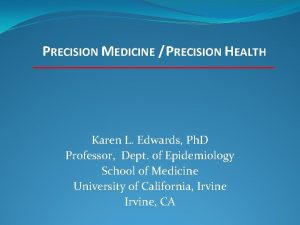Precision Medicine Legal Ethical Challenges Precision Medicine for






































































- Slides: 70

Precision Medicine: Legal & Ethical Challenges Precision Medicine for Cancer Care -Prime Time versus Provocation Treat ? Dr. Janice Tsang MBBS, MRCP(UK), FRCP (Edin. ), FRCP (Lond. ), FHKCP, FHKAM (Medicine) Specialist in Medical Oncology Hon. Clinical Assistant Professor Li Ka Shing Faculty of Medicine The University of Hong Kong Founding Convenor Hong Kong Breast Oncology Group 8 th April , 2016

Disclosures • Janice Tsang • Consultant or Advisory Role: Astra. Zeneca, Eisai, Glaxo. Smith. Kline, Novartis & Pfizer

Cancer is an aging disease… • CANCER is an aging disease, though the shared mechanisms underpinning the two processes remain unclear. • Genomic instability is a hallmark of both aging and carcinogenesis • The incidence of cancer increases with age: – exploitation of large-scale population screening programs – the improvement of diagnostic capacities worldwide Agostar B et al. The management of cancer in the elderly: targeted therapies in oncology. Immunity & Aging. 2008 Dec 30; 5: 16. doi: 10. 1186/1742 -4933 -5 -16.

Conventional Cancer Treatment • The MAINSTAY of treatment for cancer in the old days: – Surgery – Radiotherapy – Chemotherapy Not curative for metastatic disease Locoregional side effects, Palliative for advanced disease Systemic side effects, Only adjunct in most cases

Summary of Molecular Targeted Therapy -over the last 2 decades… Cancer Type Targeted Therapies CML Imatinib, Sunitinib, Dasatinib, Nilotinib… Other Haemic Malignancies Rituximab, Alemtuzumab, Bortezomib… Breast Cancer Trastuzumab, Lapatinib, Pertuzumab, TDM 1, Everolimus, Palbociclib (anti-CDK 4/6) Colorectal Cancer Bevacizumab, Cetuximab, Panitumumab… Hepatocellular Carcinoma Sorafenib, Bevacizumab… Lung Cancer (NSCLC) Gefitinib, Erlotinib, Bevacizumab, Crizotinib, PDL-1 immunotherapy. . Pancreatic Carcinoma/ Cholangio. Ca Erlotinib, Bevacizumab… Renal Cell Carcinoma Bevacizumab, Sunitinib, Sorafenib, Temsirolimus, Everolimus, Pazopanib, Axitinib… Gastrointestinal Stromal Tumour Imatinib, Sunitinib. . . Agostar B et al. The management of cancer in the elderly: targeted therapies in oncology. Immunity & Aging. 2008 Dec 30; 5: 16. doi: 10. 1186/1742 -4933 -5 -16.

Where we are today and where we hope to be tomorrow… – using Breast Cancer as an illustration First molecular targeted monoclonal antibody (trastuzumab)1, 2 1998 First HER 2 dimerisation Inhibitor (pertuzumab)4 2006– 2007 First Tyrosine Kinase inhibitor (lapatinib)3 Under investigation (phase II/III)6, 7 m. TOR inhibitors Other TKIs Combinations of HER 2 targeted therapies 2012– 2013 2014 onwards First Antibody-Drug Conjugate (ADC) (trastuzumab emtansine)5 * Only first approved indications in m. BC are shown here. 1. Slamon DJ, et al. N Engl J Med 2001; 344: 783 792; 2. Marty M et al. J Clin Oncol 2005; 23: 4265 4274; 3. Geyer C et al. N Engl J Med 2006; 355: 2733 -43; 4. Baselga J et al. N Engl J Med 2012; 366: 109 -19; 5. Verma et al. N Engl J Med. 2012 Nov 8; 367: 1783– 1791. Erratum in: N Engl J Med. 2013 ; 368: 2442; 6. Gradishar. Ann Oncol. 2013; 24: 2492– 2500; 7. Perez EA& Spano JP. Cancer. 2012; 118: 3014– 3025

Decision Making in Cancer Treatment Tumour features: T, location, Patient tumour volunme Characteristics: load, visceral Age, Co-morbidities, mets? PS, Prior Therapy IHC – e. g. ER, Pg. R Clinical Trials Patient Preference: Guidelines Qo. L/Family/Self Evidence-based data Toxicity Profile Molecular Profile (HER-2, K-ras, EGFR, EML 4 -ALK)

Background • Results of our translational research in the last decade, have revolutionized our understanding of breast cancer as a heterogeneous disease: • Genomics and transcriptomics have been helping to narrow down the number of candidate oncogenes -“One-size-fits-all” approach becomes less relevant

Changing Portraits of Breast Cancer claudin low Lum A Lum B Basal Her 2

HER 2 -enriched Claudin-low Basal-like Intrinsic Subtypes Perou et al. , Nature 2000 Normal Breast Sorlie et al. , PNAS 2001 Luminal A and B Sorlie et al. , PNAS 2003 Nielsen et al. , CCR 2004 Cheang et al. , CCR 2008 Parker et al. , JCO, Feb 2009 Cheang et al. , JNCI 2009 Prat et al. , BCR 2010 Nielsen et al. , CCR 2010 LUMINAL Cheang et al. , CCR 2012 HER 2 BASAL PROLIFERATION Relapse-free survival

Prognostic Marker – valuable if provides extra information beyond that provided by clinicopathological features • A prognostic marker – associated with clinical outcome irrespective of treatment given • tumour size, tumour grade, no. of positive lymph nodes • HER 2 amplified/overexpressed breast cancer Sparano JA et al. Sur Oncol Clin N Am. 2010; 19: 581 -606

Predictive Marker – Predicts clinical benefit from a specific therapy • ER – endocrine therapy • HER 2/neu over-expression –anti-HER 2 directed therapies – KRAS mutation for EGFR therapy – Pathological complete response (p. CR) to predict long-term survival – FDA program – Some predictive markers also prognostic Sparano JA et al. Sur Oncol Clin N Am. 2010; 19: 581 -606

FDA Definition of “Biomarker” • A characteristic that is objectively measured and evaluated as an indicator of normal biologic processes, pathogenic processes, or pharmacologic responses to a therapeutic intervention Use of biomarkers • Diagnosis • Tool for staging disease • Indicator of disease status • Predict and/or monitor clinical response to an intervention

Overview of gene expression analysis of human breast tumours Intrinsic subtypes classifier Examples: (Perou et al. Nature 2000; 406: 7471. recurrence 752; Oncotype. Dx® Sorlie et al. PNAS 2001; 98: 10869 score (Paik et al. N Engl J Med -10874) Carey L, Cheang M and Perou C. Chapter 29 “Genomics, Prognosis and Therapeutic Interventions” of Diseases of the Breast, 5 th edition, In Press 2004) 2. Mamma. Print® (Van’t Veer et al. Nature 2002; 415: 530 -536) Courtesy of Maggie Cheang

Various Genomic Platforms 1)Immunohistochemical staining (IHC 4) 2)Molecular Classification 3)Genomic Expression Profiligng Prognostic platform 4) Genomic Expression Profiling Immunomodulatory 5) Targeted sequencing 6) Whole exome (genome) sequencing 7) Big Data -The Cancer Genome Atlas (TCGA) Gene expression, Exome Sequencing, DNA copy number, mi. RNA expression, DNA methylation etc. -Molecular Taxonomy of Breast Cancer International Consortium (METABRIC) Cuzick et al. J Clin Oncol 2011

Diverse mutations of breast cancer subtypes TCGA Nature 2012

Green et al. Nature 2011 470: 204: 213

Evolution of Prediction Tools in breast cancer clinics… • We know chemotherapy reduces relative risk of death by 30 – 40% • In ER +ve disease endocrine therapy can have at least as great an effect as chemotherapy • Can we identify groups where a reduction of a small absolute risk is not worth the risks / side effects of treatment?


How should you advise this patient?

A Multi-gene Assay to Predict Recurrence of Tamoxifen-Treated Node-Negative Breast Cancer. Paik et al. , The New England Journal of Medicine, 351: 2817 -26 (2004)

Courtesy of Chuck Perou & Maggie Cheang

Neoadjuvant Setting… Relative changes in breast tumour size measured by 3 -dimensional ultrasound in BC patients receiving neoadjuvant letrozole. . .

A 4 -gene predictive model to clinical response to AI by 2 wks is associated with clinical response Deregulated immune and apoptotic responses before treatment and cell proliferation that is not reduced 2 weeks after initiation of treatment are functional characteristics of breast tumors that do not respond to AIs The molecular response to letrozole was characterized and a four-gene classifier of clinical response was established (accuracy of 96%) on the basis of the level of two genes before treatment (one gene [IL 6 ST] was associated with immune signaling, and the other [NGFRAP 1] was associated with apoptosis) and the level of two proliferation genes (ASPM, MCM 4) after 2 weeks of therapy. The four-gene signature was found to be 91% accurate in a blinded, completely independent validation data set of patients treated with anastrozole Turnbull et al. J Clin Oncol 33: 3370 -2278, 2015

Neoadjuvant Setting… Pathway signatures connections between mutations and clinical outcomes…low risk PEPI score cluster with luminal A subtype… Ki-67 <= 10% Ki-67 >10% Genomic wide somatic mutations (WGA) and response to neoadj AI

Difficult to identify the key mutation pathway in luminal BC– due to the inter-connectedness of the complicated network with too many ways to perturb a pathway… Ellis et al. Nature 486: 353 -60, 2012

Added Value of Precision Medicine in the Genomic Era • “One-size” does not fit all • Identifying the right therapy or the right patient • Enhance clinical outcomes • Increase benefit : risk ratio • Accelerate new therapeutic development for breast cancer

Added Value of Precision Medicine in the Genomic Era • New targets = new biomarkers • Efficient development of validated companion diagnostic markers essential • Translational studies important to better understand reasons for success and failure, and to gain new insights in breast cancer biology that may provide new therapeutic opportunities

Development of Genomic Signatures… • Discovery • NGS, RNA seq, proteomics • Analytical validation • Training sets and validation sets • Clinical Validation • Prognostic & Predictive value • Retrospective vs Prospective L-T FU • Compared with old therapies • Clinical Utility

Best practices for translational omics studies Institute of Medicine (www. iom. edu/translationalomics )

Emerging Treatment Options vs Challenges…

Potential of clinical cancer genomics – Scientists’ viewpoint Large-scale sequencing projects like the International Cancer Genome Consortium (ICGC) and The Cancer Genome Atlas (TCGA). Mutational signatures Focal genomic abnormalities Subtype classification Estimates of distribution and number of driver genes There is no shortage of new biomarkers available for clinical translation…. . an era of “cancer biomarker discovery”

Clinical Translation…. ? ? – Clinical biomarkers need to be highly specific and sensitive – Majority of the biomarker discoveries do not meet the criteria of high sensitivity and specificity. Biomarker publications Biomarker patents The lack of sensitivity and/or specificity leads to a low number of patent application and, in addition to this, to a low number of successful market applications.

Potential of clinical cancer genomics – Clinicians’ viewpoint

Challenges to clinical-translational application • • Source: Convenience sampling Reproducibility – Biology – Assay – Analysis • Pharmaco-economics of genomic tests • End-user of the test: Physicians and patients

Convenience sampling • Discovery-based genomic studies rely on “convenience samples” • All of the serous ovarian cancer samples analyzed in TCGA were harvested from women with advanced (Stages III and IV) tumor – making it difficult to identify critical early changes • To be meaningful in a screened population, diagnostic biomarkers must be discovered in early-stage, non-metastatic cancers since biomarker expression can change over the course of a disease.

Reproducibility - assays • Clinical application - tests need to be highly accurate & reproducible. • Very little research available into quality control of genomic studies – A recent study extracted DNA once from each part of a tumor/normal pair and shipped aliquots of this sample to five large international sequencing centers (Buchhalter et al. 2014) – Each center sequenced analyzed the sample using their own protocols. – Only ∼ 20% of mutations were common to all five centers, while one third were predicted by only a single center.

Reproducibility – inherent biology • Intra-tumoural heterogeneity – Studies universally show that individual tumors are comprised of myriad cell types present at different frequencies in different spatial sites. – Small populations of cancer stem cells that might be the source of metastatic cells and therefore represent most important information – Multiple core biopsies ? How many is enough, ? Feasibility in a patient population • Stromal interactions – Interactions of the malignant cells with the surrounding stroma, or stochastic factors that are not captured by any biomarker, are important in the progression of early lesions

Reproducibility - analysis • Significant diversity in the analysis of cancer genomic data. • Even small differences in the way a data set is preprocessed analyzed can yield massive differences in the predictions of a final biomarker – appears that the more complex the biomarker, the more sensitive it is to processing differences, both in terms of computational methodologies and sample fixation processes. • However, analysis methods cannot yet be standardized because there is very little consensus in the field about the best methods for different problems.

Pharmaco-economic of genomic tests • $$$$$$$$$$ • Limited number of pharmaco-economic studies for genomic biomarkers to date.

Cancers not limited to BC are highly dynamic evolutionary… Ongoing linear and branching evolution results in multiple simultaneous subclones that may individually be capable of giving rise to episodes of disease relapse and metastasis. The dynamic clonal architecture is shaped by mutation and competition between subclones in light of environmental selection pressures, including those that are exerted by cancer treatments.

Heterogeneity of Breast Cancer • From a single common disease to many rare diseases – Intratumoral heterogeneity • How many populations? Hierarchy? • Primary vs relapsed/metastatic tumour samples • Solid biopsy vs liquid biopsy (CTCs, plasma DNA) – Intertumoral heterogeneity • How many tumours? • Molecular segmentation or granularity? – Heterogeneity of the host • immunity

Heterogeneity of Breast Cancer Zardavas, Irrthum, Swanton & Picaart. Nat Rev Clin Oncol 12: 381 -394, 2015

Heterogeneity of Breast Cancer • Tumour heterogeneity in breast cancer even occurs at single cell level Nature 512: 155 -160, 2014

Change of ER/Pg. R & HER 2 status • 3 -28% of all metastatic lesions will either loose or acquire ER expression. • 3 -25% of the patients will loose or acquire the HER 2 overexpression or amplification. J Natl Cancer Inst 93: 1441 -6, 2001 Ann Oncol 13: 1036 -43, 2002 Br J Cancer 93: 552 -6, 2005 Cancer 103: 1763 -9, 2005

Genomic Medicine for Breast Cancer Patients (beyond ER, PR, HER 2, and chemotherapy) Ellis and Perou, Cancer Discovery, 2013 (PMID 23319768)

Further New Challenges… • The incidence of breast cancer is increasing • The breast cancer patients are living longer • Our research and clinical trials have proven success… • Matching science with the affordability… …the high expectation of the patient and the general public… patient classification, and selection for specific therapies

San Antonio Breast Cancer Symposium, December 8 -12, 2015 Yates et al, Nature Medicine Vol 21: 751 -763, 2015

San Antonio Breast Cancer Symposium, December 8 -12, 2015 Take Home • Breast cancer genomic evolution is chaotic i. e. there is no fixed temporal order • Multifocal disease is clonally related but can exhibit “clonal sweep” with dominant mutations in one focus and another set in another focus • Post-treatment samples exhibit new driver mutations, i. e. a single look for a therapeutic driver makes little sense – we need continuous genomic monitoring • Precision medicine driven by DNA sequencing of a single pretreatment sample is a naïve proposition This presentation is the intellectual property of the author/presenter. Contact mjellis@bcm. edu for permission to reprint and/or distribute.

San Antonio Breast Cancer Symposium, December 8 -12, 2015 Science Translational Medicine 26 Aug 2015: Vol. 7, Issue 302, pp. 302 ra 133

This presentation is the intellectual property of the author/presenter. Contact Nick. Turner@icr. ac. uk for permission to reprint and/or distribute.

Predicting early relapse – baseline plasma p=0. 89 69% (29/42) mutation detected in baseline plasma This presentation is the intellectual property of the author/presenter. Contact Nick. Turner@icr. ac. uk for permission to reprint and/or distribute.

San Antonio Breast Cancer Symposium, December 8 -12, 2015 Predicting early relapse – mutation tracking Improved sensitivity with dynamic mutation tracking that is highly accurate in predicting relapse This presentation is the intellectual property of the author/presenter. Contact Nick. Turner@icr. ac. uk for permission to reprint and/or distribute.

2015 and beyond… Trends in Translational Breast Cancer Research • How will documentation of complex somatic mutation patterns help breast cancer clinical care? • Is circulating Tumor DNA analysis clinically valuable?

The Way Forward – Companion Diagnostics (CDx) • HER-2 and Herceptin - now been on the market for more than a decade. However, the number of drugs marketed alongside CDx remains small • Pharmaceutical companies are increasingly looking to develop a drug and diagnostic test simultaneously, in a process referred to as drug-diagnostic-codevelopment so-called companion diagnostic (CDx), to better define the appropriate patient population for treatment. • CDx are increasingly important tools: 1. 2. 3. 4. 5. Reduced costs through pre-selected (smaller) patient population; Improved chances of approval; Significantly increased market uptake; Added value for core business (late phase); Regulatory trend to have CDx mandatory.

Choices for Clinical Trial Design 1. There is no one “right trial design” as multiple features must be taken into consideration 2. if the preliminary drug and biomarker data are very strong, then single arm Phase II studies may be enough 1. if possible, an “adaptive step” is desirable for promising drugs/biomarkers, but this adds cost and the need for real time trial monitoring of response rates 2. if there is a question as to the efficacy of the drug, or the clinical validity of the biomarker, or multiple biomarkers, then a randomized design may be best. This design also provides maximal opportunities for discovery Courtesy slide of Charles Perou

Proteomics in Clinical Trials Basket Trials -aim to test one drug or one particular genetic mutation across multiple organs. Umbrella Trials -seek to test a drug or drugs across multiple genetic mutations within a particular type of cancer. For example, the I SPY-2 umbrella trial in breast cancer. “Transforming lives through research”, AACR (2014)

The UK Molecular profiling of Advanced breast cancer to inform Therapeutic Choices (MATCH study) Clinical Leads: Dr Nicholas Turner (Royal Marsden) & Dr Alistair Ring (Brighton and Sussex) Molecular Sequencing Lead: Dr David Gonzalez de Castro (Institute of Cancer Research / Royal Marsden) Methodology Lead: Prof Judith Bliss (ICR-CTSU) Proposed funders: applications under review by Breakthrough Breast Cancer & Cancer Research UK Proposed pharmaceutical partners: Astra. Zeneca Courtesy of Stephen Johnston

Challege of Aging Society & Aging Cancer Patients By 2030, there could be 50% more people greater than 65 years old, and 100% more people greater than 80 years old By the year 2030, most patients with cancer will be aged over 65 years and many will be frail. Agostar B et al. The management of cancer in the elderly: targeted therapies in oncology. Immunity & Aging. 2008 Dec 30; 5: 16. doi: 10. 1186/1742 -4933 -5 -16. Courtesy of Dr. Joseph Kwan

Elderly People – Same age otherwise…

Both are 80+ year-old… Will you treat them for cancer?

Same age yet having different life expectancies Water LC et al , JAMA 2001

• The first prognostic scoring system for elderly cancer patients to date develop based on the CGA. • Important descriptive information on elderly Asian cancer patients gleaned. • A nomogram able to predict an individual patient’s 1, 2 and 3 year survival with reasonably good accuracy. Karnesvaran et al, JCO 2011 • The largest prospective study of CGA done on elderly cancer patients in Asia with 803 patients from 9 hospitals in Beijing who were 65 y. o. or above with a diagnosis of cancer at any stage. • Using CGA questionnaire with Chinese translation of the Gero-Oncology Health & Quality of Life Assessment Tool –demonstrated CGA appropriate for Chinese cancer patients • Mean age of 72, 59. 8% being male, 45% had concurrent TCM, 70% ADL-I Karnesvaran et al, JGO 2014

SIOG on Geriatric Assessment in Elderly Cancer Patients • Adjuvant chemotherapy for breast cancer: – Reduces relative death risk by 15. 3% • Beta-blockers for myocardial infarction: – Reduces MI relative mortality by 22% • CGA might reduce mortality by 14% for elderly cancer patients – M. Etermann , H. Cohen 2000

Conclusion • We have entered the genomic era where we are one step forward to further enhancement of personalized medicine and precision medicine. • Clinical validity is demonstrated yet awaiting the prime time for clinical utility with demonstration of clinically meaningful benefit. • Basket trial or umbrella trial should be the trend with prospective L-T FU with mutational analysis.

Conclusion • There are emerging new technologies with liquid biopsy (CTCs, ct. DNA), leading to potential serial and non-invasive mutational analyses, likely to become available in the near future. • Efforts to realize the dream of PRECISION MEDICINE for breast cancer (or other cancers) will include drug development and intelligent design of clinical trials for increasingly small subgroup of patients with specific host and disease characteristics through a multidisciplinary platform.

The Multidisciplinary Team Model for Cancer Care (MDT Model) Clinical Oncologists Medical Oncologists Basic Scientists Dietitians Occupational Therapists Surgeons Cancer Patients Pathologists Nurse Specialists Physiotherapists Medical Social Workers Clinical Psychologists

Thank You!

Acknowledgements The Centre for Law, Medicine & Life Sciences of the University of Cambridge The Centre for Medical Ethics & Law, The University of Hong Kong (HKU) Dr. Philip Beh, CMEL & MEHU, LKS Faculty of Medicine, HKU Dr. Anthony Ng, Wyng Foundation Dr. Maggie Cheang, Senior Scientist, CTSU, Institute of Cancer Research, UK All the breast and non-breast cancer patients and collaborators

Precision Medicine: Legal & Ethical Challenges Precision Medicine for Cancer Care -Prime Time versus Provocation Treat ? Dr. Janice Tsang MBBS, MRCP(UK), FRCP (Edin. ), FRCP (Lond. ), FHKCP, FHKAM (Medicine) Specialist in Medical Oncology Hon. Clinical Assistant Professor Li Ka Shing Faculty of Medicine The University of Hong Kong Founding Convenor Hong Kong Breast Oncology Group 8 th April , 2016
 Ethical issues in precision medicine
Ethical issues in precision medicine Example of a non-precision measuring instrument
Example of a non-precision measuring instrument Semi precision attachments
Semi precision attachments Bcd gösterimi
Bcd gösterimi Security and ethical challenges
Security and ethical challenges Globalization definition
Globalization definition Security and ethical challenges
Security and ethical challenges Ethical reasoning model army
Ethical reasoning model army Csr and business ethics
Csr and business ethics The perceived relevance or importance of an ethical issue
The perceived relevance or importance of an ethical issue Perbedaan ethical dilemma dan ethical lapse
Perbedaan ethical dilemma dan ethical lapse Legal and ethical environment of business
Legal and ethical environment of business Legal and ethical issues in use of ict in education
Legal and ethical issues in use of ict in education Chapter 5 legal and ethical responsibilities worksheet
Chapter 5 legal and ethical responsibilities worksheet Ethical and legal responsibilities of healthcare workers
Ethical and legal responsibilities of healthcare workers Legal and ethical issues in computer security
Legal and ethical issues in computer security Chapter 6 legal and ethical issues
Chapter 6 legal and ethical issues What ishipaa
What ishipaa Chapter 4 legal and ethical responsibilities
Chapter 4 legal and ethical responsibilities Chapter 5 legal and ethical responsibilities
Chapter 5 legal and ethical responsibilities Chapter 2 legal and ethical aspects of nursing
Chapter 2 legal and ethical aspects of nursing Legal and ethical issues in information security
Legal and ethical issues in information security Ethical media issues
Ethical media issues Ethical and legal issues affecting the nursing assistant
Ethical and legal issues affecting the nursing assistant Attack sophistication vs intruder technical knowledge
Attack sophistication vs intruder technical knowledge Professional and ethical issues during internship
Professional and ethical issues during internship Legal and ethical issues chapter 5
Legal and ethical issues chapter 5 Legal and ethical responsibilities of a coach
Legal and ethical responsibilities of a coach Chapter 2 ethical and legal issues
Chapter 2 ethical and legal issues Chapter 3 legal and ethical issues
Chapter 3 legal and ethical issues Legal issues in psychiatric nursing
Legal issues in psychiatric nursing Chapter 6 legal and ethical issues
Chapter 6 legal and ethical issues Legal, social, ethical and professional issues in computing
Legal, social, ethical and professional issues in computing What is the difference between ethical and legal issues
What is the difference between ethical and legal issues Legal and ethical issues chapter 5
Legal and ethical issues chapter 5 Chapter 2 ethical and legal issues
Chapter 2 ethical and legal issues Chapter 2 ethical and legal issues
Chapter 2 ethical and legal issues Chapter 2 ethical and legal issues
Chapter 2 ethical and legal issues Chapter 6 legal and ethical issues
Chapter 6 legal and ethical issues Chapter 5 legal and ethical responsibilities
Chapter 5 legal and ethical responsibilities Legal and ethical issues of e commerce
Legal and ethical issues of e commerce Ethical framework
Ethical framework Medical legal and ethical issues chapter 3
Medical legal and ethical issues chapter 3 Dho chapter 5 legal and ethical responsibilities
Dho chapter 5 legal and ethical responsibilities Legal issues in community health nursing
Legal issues in community health nursing Emt chapter 3 medical legal and ethical issues
Emt chapter 3 medical legal and ethical issues Chapter 3 medical legal and ethical issues
Chapter 3 medical legal and ethical issues Martin tobin leicester
Martin tobin leicester Dr martin tobin
Dr martin tobin Precision medicine ecosystem
Precision medicine ecosystem Challenges facing family medicine
Challenges facing family medicine Ethical issues in veterinary medicine
Ethical issues in veterinary medicine Biologiska arvet
Biologiska arvet Rutin för avvikelsehantering
Rutin för avvikelsehantering Myndigheten för delaktighet
Myndigheten för delaktighet Presentera för publik crossboss
Presentera för publik crossboss Tack för att ni lyssnade
Tack för att ni lyssnade Tes debattartikel
Tes debattartikel Kung som dog 1611
Kung som dog 1611 Nationell inriktning för artificiell intelligens
Nationell inriktning för artificiell intelligens Tobinskatten för och nackdelar
Tobinskatten för och nackdelar Hur ser ett referat ut
Hur ser ett referat ut Verifikationsplan
Verifikationsplan Vad är en punkthöjd
Vad är en punkthöjd Tryck formel
Tryck formel Fuktmätningar i betong enlig rbk
Fuktmätningar i betong enlig rbk Densitet vatten
Densitet vatten Elektronik för barn
Elektronik för barn Personalliggare bygg undantag
Personalliggare bygg undantag Tack för att ni har lyssnat
Tack för att ni har lyssnat Borra hål för knoppar
Borra hål för knoppar




